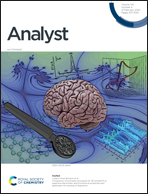A dual signal amplification strategy for the highly sensitive fluorescence detection of nucleic acids†
Abstract
The development of convenient sensing probes and strategies for the highly sensitive and specific detection of biomolecules is greatly significant for the diagnosis of diseases. Herein, a dual signal amplification strategy comprising target-triggered recycling and duplex-specific nuclease (DSN)-mediated amplifications was designed and proposed for a highly sensitive fluorescence assay of nucleic acids. In this strategy, three special hairpin structured single-stranded DNAs (i.e., H1, H2 and H3) were designed, and target-triggered recycling was operated on H1-modified AuNPs (i.e., AuNP-H1 probes) in the presence of target DNA, H2 and H3 to form trefoil DNAs on AuNPs (i.e., AuNP-trefoil). DSN was then incubated with AuNP-trefoil to cleave the double-stranded trefoil DNAs, causing the ROX molecules labelled on H2 and H3 to fall off the AuNPs, which resulted in the recovery of the previous AuNP-quenched fluorescence signal of ROX. The sensing mechanism was confirmed by polyacrylamide gel electrophoresis and fluorescence characterizations, and the sensing strategy was optimized from several aspects, such as the MCH blocking time of the AuNP-H1 probes (20 min) and the concentration (0.3 U) and immobilization time (15 min) of DSN. The practicability of the probes and the dual signal amplification strategy was investigated by a fluorescence assay of target DNA in human serum. A good linear calibration curve from 50 fM to 100 pM was obtained with a low detection limit of 47.68 fM. The sensing strategy showed good specificity, which could efficiently distinguish the target DNA from the single-base mismatched (SM) and completely unmatched (UM) DNAs. The recovery values ranging from 91.85% to 106.3% with the relative standard deviations (RSD) less than 7.30% also illustrated the good reliability of the proposed sensing probes and strategy. The AuNP-H1 probes and dual signal amplification strategy provide highly effective diagnostic agents and method for the analysis of disease-related nucleic acid biomarkers at the molecular level for early disease detection.



 Please wait while we load your content...
Please wait while we load your content...